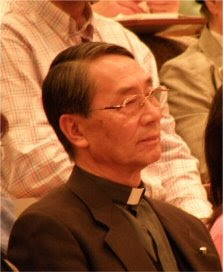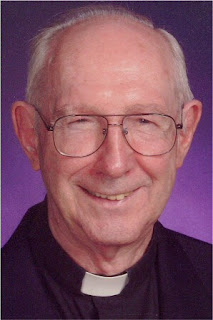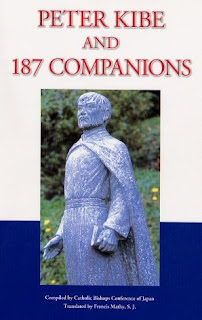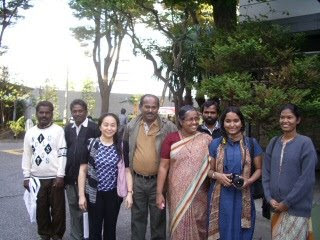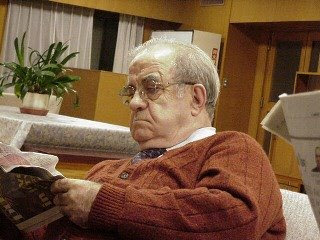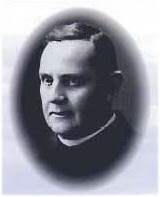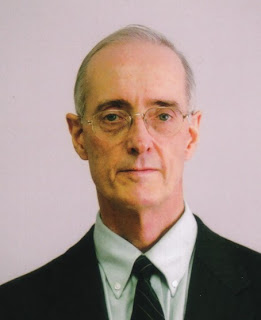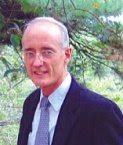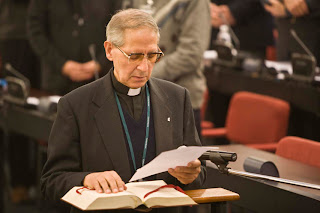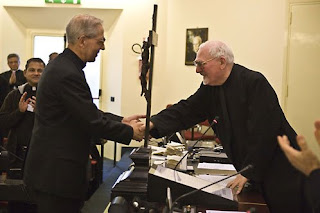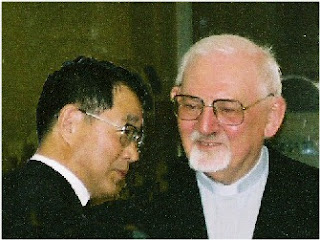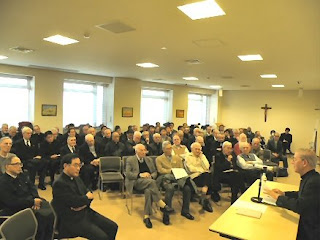s.jpg)
The General Addressing Jesuits
December 26 was a busy day for Jesuits in Japan. More than 60% of the Japanese Province, about 160 men, gathered in Kibe Hall, the Japanese Jesuit Headquarters in central Tokyo. There were young and old, brothers and priests, foreigners and Japanese, coming from far (Nagasaki and Sapporo) and near (Sophia University, next door). The formal meeting began at 10:00 AM with a prayer, followed by a welcome speech by Shogo Sumita, the Japanese Provincial. Then came the main guest of the day, the Superior General, Adolfo Nicolas, dressed in black with a roman collar, as he regularly appears these days.
"Here I feel very much at home," the General began, after introductory bows and hellos, "since so far nobody has knelt before me asking to be blessed." Peppering his talk with amusing anecdotes and entertaining episodes, he gave a brief "State of the Society" address, outlining how the headquarters of the Society function in Rome, how the relations between the Society and the Vatican are improving, and how overall the Jesuits are enthusiastic apostles rather than troublesome whiners. He highlighted especially the painstaking work that Jesuits do in the Amazon regions of Brazil, in former Communist countries, and in countries where religious freedom is non-existent. Speaking in fluent Japanese throughout, he recalled the recent beatification of Peter Kibe, S.J, and 187 martyrs and told the audience that the rest of the Society has great expectations from the Japanese Province.
s.jpg)
Jesuits together for Mass
Clearly, Nicolas is a very optimistic General, affirming the positive and encouraging the audience. He exuded confidence, hope, and enthusiasm. No dark clouds in his horizon! It has to be added, though, that his optimism was enlightened, not naive. He did point out that the Society's strength may dwindle to less than 10,000 within the next few years, and there are many challenges ahead. He also goaded the audience, with self-deprecating humor, to reflect on why Jesuits seemed to work better individually than collectively.

The Stats
After a break for lunch, Shnizo Kawamura, a Jesuit Professor at Sophia University, gave an hour-long presentation, complete with PowerPoint slides, on the 100-year history of the Society of Jesus in Japan. Beginning with the reasons that kept the Jesuits away from Japan soon after the Restoration, he introduced the major Popes and Jesuits who contributed to the growth of Jesuits and Jesuit apostolates in Japan. Perhaps the most exciting of his topics was the Church's position on Catholics 'bowing' at the Yasukuni (Shinto) Shrine in the 1930s, when, for a time, Church authorities saw no reason to forbid Catholics from visiting the shrine. The Church took such a stand since the Government, in response to a query from the Archbishop, had explained: "The visit of shrines is required from students of higher schools and students of middle and primary schools for educational reasons. The inclination required on these occasions from the students and pupils as a group has no other purpose than that of manifesting the sentiments of patriotism and loyalty." Kawamura's sobering statistics may be an eye-opener for most Jesuits and others concerned with the welfare of the Church.
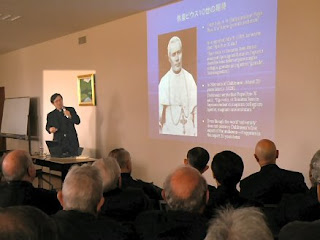s.jpg)
Kawamura Presenting
The climax of the day was surely the liturgy, in which the General acted as the chief celebrant and homilist, and seven Jesuits pronounced their final vows. In his homily, the General gave friendly advice to the vowants--especially to transcend petty worries concering troublesome superiors and defective colleagues and to focus on their avowed commitment to serve God and the Church. He also exhorted them to be 'available' as Ignatius would like them to be--adding that they might even be called upon to serve in other parts of the world.

Seven Jesuits for Final Vows
After Mass, there was a reception to celebrate not only the memorable visit of the General, but also the 100 years of Jesuit presence in Japan and the Final Vows of the 'Seven Samurai.' The General enthusiastically mingled with the crowd, meeting many old friends and making new friends as well.

Nicolas at the Reception
Photos (c) Jesuits of Japan

